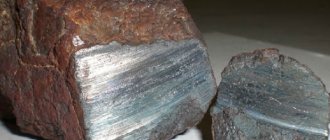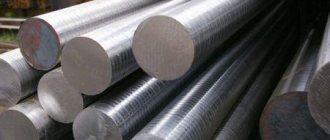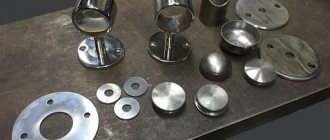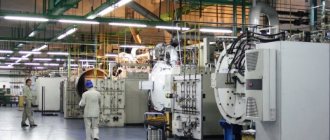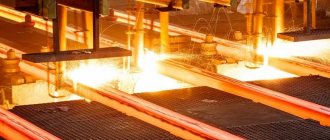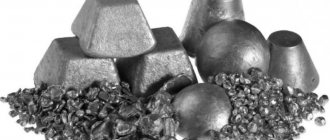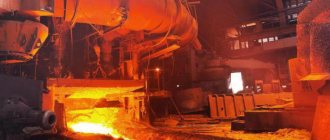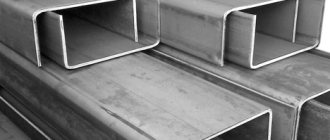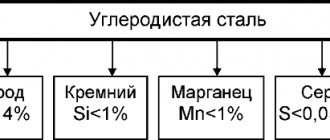Features of the material
There is a big difference between steel and cast iron. To identify it, you need to familiarize yourself with the definitions and characteristics of metals.
Cast iron
Cast iron is made up of iron and carbon. In this case, the amount of the second component should be more than 2%. Raw materials are doped with various additives. These include silicon, phosphorus, manganese and other substances.
Depending on the crystal lattice formed, there are the following types of cast iron:
- White - the name is due to the shade of the fractured material. It is associated with the presence of cementite in the composition. In addition to hardness, the material is brittle. By annealing it is used to produce malleable cast iron.
- Gray - the shade of the raw material is due to the high graphite content. The material is distinguished by its plasticity and ease of processing. The composition contains sulfur, phosphorus, magnesium and silicon.
- Malleable – Prolonged annealing of white cast iron results in the formation of graphite. This substance makes the metal very ductile, viscous and hard. In addition, it gives it good impact resistance.
- High strength - the formation of spherical graphite during crystallization provides the substance with a high degree of strength.
- Ultimate – subject to further processing. It cannot be used as an independent unit.
The melting point of this metal is at the level of 1160-1250 degrees. The specific value is determined by the carbon content. The more substance in the composition, the lower its temperature and the greater the fluidity when heated. This dependence is associated with the fragility of the substance.
Steel
This material contains 45% iron and 2% carbon. Depending on the grade, steel may contain additional substances. These include chromium, nickel, manganese, silicon and others. Depending on the alloying components, the properties of the material also change.
Carbon provides the material with hardness and strength properties. Thanks to the presence of this substance, the material is durable and flexible. It is quite easy to handle.
Depending on the content of alloying substances, steel can have the following varieties:
- low alloy;
- medium alloyed;
- highly alloyed.
Depending on the carbon content, there are the following types of steel:
- low carbon;
- medium carbon;
- high carbon.
The melting point of all brands is 1450-1520 degrees. Density parameters are at the level of 7700-7900 kilograms per 1 cubic meter.
Steel has a wide range of applications. It is used in industry in the manufacture of various types of metal structures, machine elements, pipelines and other products. In everyday life, people use interior items, dishes, and furniture made of steel.
Iron
Pure iron can only be found in laboratory conditions. In addition, it cannot be used for mass production of spare parts, plumbing fixtures or household items. Unlike cast iron, iron has a light silver tint, softness and ductility. In addition, it is highly susceptible to corrosion.
Expert opinion
Karnaukh Ekaterina Vladimirovna
Graduated from the National University of Shipbuilding, majoring in Enterprise Economics
It is important not to confuse iron with steel, which is its derivative. These concepts cannot be considered interchangeable. Steel is an alloy of iron with a small amount of additives. Sulfur, phosphorus, silicon, manganese, and carbon are used as additional components. The resulting iron-carbon alloy is elastic. It is malleable and deformable.
Methods of obtaining
The following low-carbon steels are distinguished depending on the smelting method:
- Converter furnaces. The metal melts due to the chemical heat of exothermic reactions. Excess carbon is removed by blowing oxygen through the metal mirror. The advantage of this method is high productivity. The downside is the increased concentration of nitrogen at the outlet.
- Open hearth furnaces. Liquid fuel is burned in the working chamber. The required melting temperature is achieved due to the heat of the exhaust gases. With this method, the alloy turns out to be more deoxidized and with a lower content of non-metallic impurities.
- Electric furnaces. They have a more advanced smelting method. All high-quality grades of low-carbon steel are smelted only by this method. The advantage here is the ease of adjusting the thermal regime and the possibility of using slags and fluxes. The downside is significant energy costs.
Low-carbon steel is in greater demand in mechanical engineering and, especially, construction. It is these industries that provide it with constant demand for several decades. And judging by the expanding cities and developing industries, the need for carbon steel will only increase.
Rate this article:
Rating: 0/5 — 0 votes
How are they different?
Carbon components give the molecular structure strength and hardness. At the same time, the fragility of products increases under heating, shock and vibration loads. Plastic material easily withstands these types of impacts.
The main difference between cast iron and steel is the carbon content. Alloys can be alloyed with the same metals. However, the results are different. This is due to differences in the carbide lattices.
Composition and microstructure
When making steel, iron, carbon and impurities are combined. Moreover, the amount of carbon in the composition should be no more than 2%, and the iron content should be no less than 45%. The remaining percentage comes from alloying substances - they are used to bind the mixture. Such components include chromium, nickel, and molybdenum.
Due to the presence of carbon, iron becomes more durable and acquires the required hardness. Without it, the mass would turn out viscous and plastic.
Cast iron is also made from iron and carbon. However, the amount of the second component in the mixture exceeds 2%. In addition, permanent impurities are also introduced into the cast iron. These include phosphorus, sulfur, silicon, manganese, as well as alloying substances.
Production
In production conditions, the type of metal can be determined in the following ways:
- By fracture - this visual method is used for parts that are scrapped or used as blanks. A matte dark gray color is noticeable on scrap cast iron. In this case, the cracks that form have a pronounced structure. Steel products are lighter and have a glossy surface.
- Drilling – steel shavings have a twisted shape. It is longer than the drill and bends easily. Cast iron shavings crumble even with slight impact.
- Grinding - as a result of the passage of a grinding machine, the steel surface is covered with a large number of yellow and white sparks. Cast iron has fewer sparks. In addition, they are shorter and have a reddish tint.
Characteristics
It is possible to identify differences between workpieces that can be processed by visual signs. On scrapped cast iron products, a dark gray tint with a matte surface is visible. At the same time, the steel has a lighter color and glossy texture.
The appearance of the metal is influenced by the amount of carbon components. They can be distinguished by the type of cracks. High-carbon steel surfaces are characterized by defects in the form of splitting. If the product is made of a low-carbon alloy, the cracks resemble a plastic break.
Differences between metals also lie in technical characteristics. Steel has the following properties:
- density – 7700-7900 kilograms per 1 cubic meter;
- melting point – 1450-1520 degrees;
- strength, wear resistance, hardness;
- resistance to deformation;
- high ductility - this helps to process metal in different ways;
- the possibility of improving the quality of the material through hardening;
- the possibility of improving the properties of the alloy by introducing alloying additives.
Cast iron is also an alloy of iron and carbon. However, the content of the second component is higher. The same applies to additional components. Therefore, cast iron is considered a more fragile material - it breaks easily.
The melting point of cast iron depends on the carbon content. As the volume of this component increases, the temperature decreases. In addition, there is an increase in fluidity when heated. This does not have the best effect on the performance properties - fragility, ductility, ease of processing. The melting point of cast iron is 1160-1250 degrees.
Strength
Steel is stronger compared to cast iron. It is stronger due to its structure. The increased carbon content in cast iron makes it more brittle and less ductile.
Carbon content
Steel differs from cast iron in carbon content. The amount of this component in the metal does not exceed 2%. Cast iron typically has a carbon volume greater than 2.14% but less than 4.5%.
Scope of application
Cast iron is considered a casting material. It is used to make simple dishes, machine bodies, and massive pipes. Large objects of simple configuration are also made from metal. Parts of different sizes and complexity are made from steel, since forging, drawing, stamping, and rolling are used for this. It is also permissible to use other processing methods for this metal.
Expert opinion
Karnaukh Ekaterina Vladimirovna
Graduated from the National University of Shipbuilding, majoring in Enterprise Economics
If the question arises what the reinforcement is made of, there is no doubt - it is steel. If you are interested in the composition of a large cauldron, you can say with confidence that it is made of cast iron. In this case, the engine housing or crankshaft can be made of any metal. Therefore, in this case, you need to resort to recognition methods.
Sauna stoves made of cast iron are the most popular, but there are nuances
There is an opinion among the common people that cast iron stoves are the ideal option. This conclusion has its reasons. Firstly, cast iron is a material that practically does not burn out. With proper operation, a cast iron stove will last ten, or even twenty-plus years! However, there is one caveat here - such a period can actually occur if the manufacturer uses a good alloy and follows the casting technology. The casting must be even and smooth.
Fig 1. Cast iron firebox of the Vesuvius Legend bathhouse stove
At first glance, if this condition is met, then everything is ideal, but cast iron has its own Achilles heel - fragility. In other words, with sudden changes in temperature, such a stove can simply burst - and, you see, this is not the most pleasant situation for bath procedures.
Moiseev Rodion Senior salesman in a store on Vyborg highway. 212
By the way, if you have not yet decided on the stove model, we recommend reading our article “Which stove is best for a Russian bath.”
The second nuance of the material is that cast iron takes a long time to heat up, although it takes longer to cool down.
The heating time for a steam cast iron stove is 1.5-2 hours. Cooling time is the same. The burnout temperature of a cast iron stove is 1200 degrees Celsius.
Another nuance of cast iron stoves is their thickness. You should pay special attention to the thickness of the material if the casting is not of the best quality (for example, it has potholes or holes). In this case, for a long service life of the furnace, the thickness should be at least 15-20 mm. If the casting is of good quality, then the thickness can be less - 8-12 mm.
As for the cost of cast iron stoves for a bath, prices for such stoves start from 25 thousand rubles. This is 20-25% more expensive than stoves made of black or boiler steel, but, for example, professional models of cast iron stoves will be comparable in price to the price of steel stoves.
Moiseev Rodion Senior salesman in a store on Vyborg highway. 212
If you want to compare the cost of stoves made of different materials, use the stove selection filter on our website.
Pros and cons of each metal
Alloys have certain advantages and disadvantages. The advantages of steel include the following:
- high margin of strength and hardness;
- a large number of properties - this is due to different options for alloying impurities;
- optimal ratio of elasticity and viscosity - the material perfectly withstands static, dynamic and shock loads;
- ease of processing;
- high margin of safety - due to this, the material has a long service life;
- simplicity and affordable cost of casting.
However, the material also has a number of disadvantages:
- poor corrosion resistance - this applies to pure types of steel that do not contain alloying components;
- high electromechanical corrosion - this is due to the property of storing electrical energy;
- heavy weight of steel structures;
- high risk of defects - this is due to the multi-stage manufacturing process.
Cast iron has the following advantages:
- high level of strength - some brands are comparable in this parameter to steel;
- uniform heat distribution and the possibility of long-term preservation;
- safe composition - this allows the use of cast iron for making cookware;
- resistance to acids and alkalis;
- high degree of hygiene;
- durability.
However, metal also has some disadvantages:
- risk of corrosion processes due to prolonged exposure to water;
- lack of ductility of gray cast iron;
- increased fragility of white material.
Impact resistance
For now, you may think that using cast iron has more advantages than using steel, but steel does have one major advantage: impact resistance. Steel can withstand sudden impacts without bending, warping or breaking. This is due to its strength: its ability to withstand high loads.
Strength without ductility results in a brittle material that is very susceptible to fracture, and cast iron is the poster child for the definition of strength without ductility. Due to its brittleness, cast iron has a limited range of applications.
The impact resistance and load-bearing nature of steel make it optimal for many mechanical and structural applications, which is why steel is the most widely used metal in the world.
Quick comparison table
The main differences between metals are briefly presented in the table:
| Steel | Cast iron |
| Has high strength and hardness. | It is considered a more fragile and less ductile material. |
| Has a higher melting point. | Differs in lower melting temperatures. |
| Contains less than 2% carbon. | Includes more than 2% carbon. |
| It is less porous and has greater thermal conductivity. | Contains more pores and is characterized by lower thermal conductivity. |
| It has a light shade and shiny surface. | It is distinguished by its dark color and matte surface. |
| Has a higher cost. | It costs less. |
Stainless steel stoves - the best performance
Today, stainless steel fireboxes are rightfully considered one of the best on the market. Judge for yourself: the heat resistance of such sauna stoves is as much as 800 degrees! This is 200-300 degrees higher than the maximum temperature inside the sauna stove. It follows from this that scale will not form in such furnaces.
The burnout temperature of stainless steel stoves is 800 degrees Celsius. Thickness - 2-6 mm.
The high temperature resistance also determines that the stove will serve faithfully for a very long time - more than 20 years! Durability is not the only advantage of such stoves: they are not fragile, quickly heat the steam room, and are available in various design solutions.
Fig. 4. Grill'D PRO series sauna stoves are made of stainless steel 4 mm thick.
The only disadvantage of stainless steel stoves is the price. It is 2-3 times higher than the price of stoves made of structural steel or 09g2s. In order to level out the difference, stoves are produced from stainless steel with a thickness of 2 mm. The price becomes comparable to stoves made of black steel (from 15 thousand rubles), but 4-6 mm models still remain on sale. thick (from 40 thousand rubles).
By the way, we did not stipulate at the very beginning that the article will focus specifically on stoves for baths, and not for saunas. If you have not delved into this issue yet, we recommend that you read our article: “What is the difference between sauna stoves and sauna stoves.”
Corrosion resistance
Cast iron has better corrosion resistance than steel. However, both metals oxidize when exposed to moisture.
Paint or powder coating is recommended to prevent corrosion. They protect both cast iron and steel surfaces well.
Any chip or crack that the base metal is exposed to can lead to corrosion, so regular maintenance is important for coated metals. If corrosion resistance is an important factor, alloy steel, particularly stainless steel that has chromium and other alloys added to prevent oxidation, is probably the best choice.
Production volumes
Cast iron cast into ingots Play media
Release of pig iron from a blast furnace
In 1892, Germany produced 4.9 million tons of pig iron, against 6.8 in England, and in 1912 it was already 17.6 against 9.0[29]
World production of pig iron in 2009 amounted to 898.261 million tons, which is 3.2% lower than in 2008 (927.123 million tons)[30]. The top ten pig iron producing countries looked like this:
| Place in 2009 | A country | Pig iron production, million tons |
| 1 | China | 543,748 |
| 2 | Japan | 66,943 |
| 3 | Russia | 43,945 |
| 4 | India | 29,646 |
| 5 | South Korea | 27,278 |
| 6 | Ukraine | 25,676 |
| 7 | Brazil | 25,267 |
| 8 | Germany | 20,154 |
| 9 | USA | 18,936 |
| 10 | France | 8,105 |
For four months of 2010, global production of pig iron amounted to 346.15 million tons. This result is 28.51% more compared to the same period in 2009.[31]
Marking
In industry, types of cast iron are labeled as follows:
- pig iron - P1, P2;
- pig iron for castings (pipe casting) - PL1, PL2;
- pig iron - PF1, PF2, PF3;
- conversion high-quality cast iron - PVK1, PVK2, PVK3;
- cast iron with lamellar graphite - SCh (numbers after the letters “SCh” indicate the value of tensile strength in kgf/mm).
- anti-friction gray - ASF;
- anti-friction high-strength - AChV;
- anti-friction malleable - ABC;
- cast iron with nodular graphite for castings - HF (the numbers after the letters “HF” mean tensile strength in kgf/mm and relative elongation (%);
- alloyed cast iron with special properties - Ch.
Malleable cast iron is marked with two letters and two numbers, for example KCH 37-12. The letters KCH mean malleable cast iron, the first number is the tensile strength (in tens of megapascals), the second number is the relative elongation (in percent), characterizing the ductility of cast iron.
Notes
- ↑ 12
Wegman et al., 2004, p. 41. - Start of iron foundry
- Karabasov et al., 2012, p. 54.
- Wegman et al., 2004, p. 39.
- Numismatic Legacy of Wang Mang, AD9-23 by Henz Hratzer, AMFishman, 2022. 中国古钱大集华光普着甲册 2008年版. January 2009
- Chinese coins
- Archaeologists have found a 14th century Golden Horde cauldron on the Kulikovo Field
- Terekhova N. N. Iron foundry technology of the ancient Mongols
- What are bells made from?
- ↑ 12345678
Cast iron / Milman B. S., Kovalevich E. V., Solenkov V. T. // Chagan - Aix-les-Bains. - M.: Soviet Encyclopedia, 1978. - P. 248-249. - (Great Soviet Encyclopedia: [in 30 volumes] / chief editor A. M. Prokhorov; 1969-1978, vol. 29). - ↑ 12
Korotich, 2000, p. 178. - History of firearms from ancient times to the 20th century
- Artillery gun (history of invention)
- About tsarist artillery and cannon casting
- Wegman et al., 2004, p. 40.
- History of the locomotive
- Cast iron for Russian stove
- Wegman et al., 2004, p. 51-52.
- Wegman et al., 2004, p. 53.
- Karabasov et al., 2011, p. 138-140, 144-153.
- L. G. Beskrovny.
Army and Navy in the 18th century.. - M.: Military Publishing House of the Ministry of Defense of the USSR, 1958. - P. 361. - 662 p. - Domain revolution
- Victorian and Georgian style and fireplace design (unspecified)
(inaccessible link). Retrieved October 15, 2022. Archived October 15, 2022. - A. N. Grablev.
Machines and foundry technology. - M.: MGIU, 2010. - P. 14. - 228 p. — ISBN 978-5-2760-1857-7. - Underground London: Water and Sewerage
- Zimmerman, Gunter, 1982, p. 245, 253.
- Zimmerman, Gunter, 1982, p. 246.
- Zimmerman, Gunter, 1982, p. 245.
- Lenin. Imperialism, as the highest stage of capitalism, ch. 7.
- World production of pig iron in 2009 decreased by 3.2% (inaccessible link)
- The world's production of cast iron is growing.
